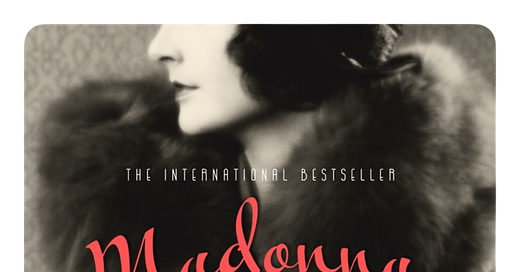first book newsletter of 2025: my unpopular opinion
my review of Madonna in a Fur Coat by Subahattin Ali
A few weeks ago, I and many other people came across a viral tweet recommending Madonna in a Fur Coat by Sabahattin Ali. In filming my January wrap up video, I completely forgot to talk about this book. I guess in the scrolling through my Goodreads process of looking through the record of books I’ve read over the course of the last month, I just skipped over this title entirely. Which is unfortunate, because I had a hot take on it! Which I did speak to a bit in my short review on Goodreads.
Like many other people, I went into this book with no expectations. The tweet recommending the book explicitly said not to look up anything about it before reading it, and I followed that recommendation. The framing device for the heart of the novel, a story about a man who becomes a shell of himself after losing the love of his life, is the first person narration of his coworker prying into his personal life.
However, the life-love in question is written as a woman whose appeal seems to be found in her mystery; her enigmatic charm and difference from other women as purported by both herself and the man pursuing her is couched in her directness. The Madonna in the fur coat in question denies this man sexual access to her in a way that first prompts jealousy from the man, and later becomes part of what makes her the singular love of his life.
It’s evident from even the first encounter with the figure of this woman, the object of desire and affection, that she is merely that: an object. Because the first encounter this man has with this woman is one where he is literally looking at her as portrayed in a painting, everything about his understanding of his experience with this woman is colored by the fact that his first experience of attraction to and desire for her exists within the context of her image as captured in an object of art. She is literally first presented to him as an object, a painting.
We eventually see how the Madonna in question finds his constant revisits to the art gallery, specifically to gaze upon the painting of her, endearing and amusing. (Not creepy at all!) She seems to revel in watching him return day after day to look upon her painted visage. When she eventually confronts him and he is hit with the understanding that she is the woman in the painting he so admires and is so drawn to, he feels inadequate due to his previous inexperience with women. He languishes over this fact in his journal, which is where the framing device of the story allows for this romantic plotline to unfold.
As the man lies on his deathbed, years after this passionate love affair, the coworker whose perspective we are in for the beginning and end of the novel, is given permission to read the notebook (where the exploits with the Madonna are recorded, and which constitute the majority of the novel) before throwing it in the fire. It’s compelling, but was perhaps a more original conception for a story in its time of publication (1943) than it is now.
Maybe I’m just too much of a mean man-hating lesbian or whatever, but I was prevented from being moved by the story of longing and yearning that the book works to poignantly convey by the creeping lines of misogynistic rhetoric and framing around the depiction of desire. The Madonna in her fur coat felt more like an idea than a fully realized and fleshed out person, a quirky sort of manic pixie dream girl whose absence speaks to the complexity and depth of the main male characters’ feelings and emotions. We never get to occupy her perspective, outside of the mentions of letters and reconnections we get towards the end of the book.
Ultimately and unpopularly, according to the many Goodreads friends’ four and five star reviews of this title, I found this book unsatisfying. It’s a book that seems to hate women while loving one woman– a woman who remains a performer (she’s a cabaret girl in Berlin) and an enigma and is held at a distance to be examined from afar, even as she steps out of the painting and into the narrative.




